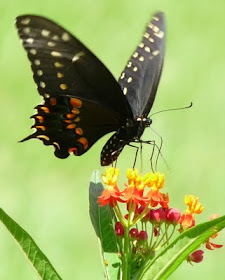 We continue to be without a camera here in MFB, but our ears are working, and through our closed windows, with the AC running, I can still hear the raucous cry of the limpkin outside on the shore.
We continue to be without a camera here in MFB, but our ears are working, and through our closed windows, with the AC running, I can still hear the raucous cry of the limpkin outside on the shore.If you've never heard the cry of the limpkin, it's rather hard to describe. Whatbird.com describes it as ""kkrrrraaow", which just doesn't do it justice. Imagine a cat whose tail has just been stepped on, crossed with a very hungry baby, and you might get something close. The strength of the cry is really unbelievable - if you live in a limpkin neighborhood, you know what it's like to wake up to that insane noise.
 We saw very little of this delightful wading bird until we moved to My Florida Backyard, where apple snails and freshwater mussels (the limpkin's major food sources) are abundant. Now, rarely a day goes by that I don't see one or more of these guys stalking the water's edge. When they nab a mussel or snail, they bring it up on shore and begin the process of extracting the yummy stuff inside.
We saw very little of this delightful wading bird until we moved to My Florida Backyard, where apple snails and freshwater mussels (the limpkin's major food sources) are abundant. Now, rarely a day goes by that I don't see one or more of these guys stalking the water's edge. When they nab a mussel or snail, they bring it up on shore and begin the process of extracting the yummy stuff inside. In this picture from last summer, the limpkin is prying open a freshwater mussel, but I find it even more fascinating to watch them extract the meat from an apple snail. Their beak actually curves slightly to one side so they can slide it into the shell opening. They slice out and remove the meat, almost never breaking the shell itself. The shoreline of our lake is littered with empty apple snail and mussel shells, proof of the abundance of food provided for these birds in our small suburban pond.
In this picture from last summer, the limpkin is prying open a freshwater mussel, but I find it even more fascinating to watch them extract the meat from an apple snail. Their beak actually curves slightly to one side so they can slide it into the shell opening. They slice out and remove the meat, almost never breaking the shell itself. The shoreline of our lake is littered with empty apple snail and mussel shells, proof of the abundance of food provided for these birds in our small suburban pond. We're actually fortunate to have limpkins here at all. Although they are very common in tropical America, their population in peninsular Florida (the only place they're found in the U.S.) has dwindled. Settlers hunted them for food in the early days of Florida, and as development threatens the wetlands that provide their food source, the Florida limpkin's future is somewhat uncertain. They are listed as a Species of Special Concern (SSC).
We're actually fortunate to have limpkins here at all. Although they are very common in tropical America, their population in peninsular Florida (the only place they're found in the U.S.) has dwindled. Settlers hunted them for food in the early days of Florida, and as development threatens the wetlands that provide their food source, the Florida limpkin's future is somewhat uncertain. They are listed as a Species of Special Concern (SSC).Quite honestly, though, you'd never know it in My Florida Backyard. Limpkins are a constant source of company here, day and night, winter and summer, wet and dry, and I hope that our efforts to preserve the health of our pond will allow them to continue to thrive. Their shrill cry is sometimes annoying, but I can't bear to imagine the silence if their cry were removed forever.

































